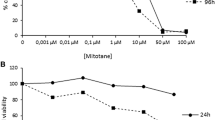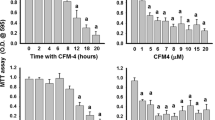Abstract
Purpose
19-Nor-1α,25-dihydroxyvitamin D2 (paricalcitol) is an analogue of 1,25(OH)2D3 with reduced calcemic effects that is approved for the suppression of parathyroid hormone in chronic renal failure. Paricalcitol has recently been reported to have anticancer activity in prostate cancer. In order to explore paricalcitol as a potential agent against leukemia, we tested its effects on HL-60 and U937 leukemia cell lines.
Methods
We studied cellular differentiation via expression of CD11b and CD14 surface antigens using flow cytometry, and via the nitroblue tetrazolium (NBT) assay. Cell cycle was analyzed using propidium iodide staining. Apoptosis was assessed with the annexin V assay. Cellular proliferation was determined via colony inhibition on semisolid medium.
Results
Paricalcitol induced the maturation of HL-60 and U937 cells, as shown by increased expression of CD11b differentiation surface antigen. CD14 showed increased expression in HL-60 but not in U937 cells. After exposure to paricalcitol at 10−8 M for 72 h, the ability of HL-60 cells to reduce NBT was markedly increased. Conversely, U937 cells were unchanged. Paricalcitol inhibited colony formation of both HL-60 and U937 cell lines in semisolid medium after a 10-day incubation (estimated IC50 of 3×10−8 M in HL-60 cells and 4×10−8 M in U937 cells). Paricalcitol at 10−8 M and 10−7 M caused a significant dose- and time-dependent increase of apoptosis in HL-60 cells (P<0.05). In both HL-60 and U937 cells, exposure to 10−7 M paricalcitol for 72 h increased the number of cells in G0/G1 phase, and decreased the number of cells in S phase.
Conclusions
Paricalcitol inhibits colony formation, induces maturation and causes cell cycle arrest in HL-60 and U937 cells. Additionally, paricalcitol induces apoptosis in HL-60 cells. These findings support the further evaluation of paricalcitol as an antileukemia agent.





Similar content being viewed by others
References
Abe E, Miyaura C, Sakagami H, Takeda M, Konno K, Yamazaki T, Yoshiki S, Suda T (1981) Differentiation of mouse myeloid leukemia cells induced by 1α,25-dihydroxyvitamin D3. Proc Natl Acad Sci U S A 78:4990–4995
Albanell J, Han W, Mellado B, Gunawardane R, Scher HI, Dmitrovsky E, Moore MA (1996) Telomerase activity is repressed during differentiation of maturation- sensitive but not resistant human tumor cell lines. Cancer Res 56:1503–1508
Arlet P, Nicodeme R, Adoue D, Larregain-Fournier D, Delsol G, le Tallec Y (1984) Clinical evidence for 1,25-hydroxycholecalciferol action in myelofibrosis. Lancet 1:1013–1014
Asou H, Koike M, Elstner E, Cambell M, Le J, Uskokovic M, Kamada N, Koeffler HP (1998) 19-nor vitamin-D analogs: a new class of potent inhibitors of proliferation and inducers of differentiation of human myeloid leukemia cell lines. Blood 92:2441–2449
Blutt SE, Allegretto EA, Pike JW, Weigel NL (1997) 1,25-dihydroxyvitamin D3 and 9-cis-retinoic acid act synergistically to inhibit the growth of LNCaP prostate cells and cause accumulation of cells in G1. Endocrinology 138:1491–1497
Chen TC, Schwartz GG, Burnstein KL, Lokeshwar BL, Holick MF (2000) The in vitro evaluation of 25-dihydroxyvitamin D2 as therapeutic agents for prostate cancer. Clin Cancer Res 6:901–908
Devitt A, Moffatt OD, Raykundalia C, Capra JD, Simmons DL, Gregory CD (1998) Human CD14 mediates recognition and phagocytosis of apoptotic cells. Nature 392:505–509
Elstner E, Linker-Israeli M, Umiel T, Le J, Grillier I, Said J, Shintaku IP, Krajewski S, Reed JC, Binderup L, Koeffler HP (1996) Combination of a potent 20-epi-vitamin D3 analogue (KH 1060) with 9-cis- retinoic acid irreversibly inhibits clonal growth, decreases bcl-2 expression, and induces apoptosis in HL-60 leukemic cells. Cancer Res 56:3570–3576
Godyn JJ, Xu H, Zhang F, Kolla S, Studzinski GP (1994) A dual block to cell cycle progression in HL60 cells exposed to analogues of vitamin D3. Cell Prolif 27:37–46
Hisatake J, O'Kelly J, Uskokovic MR, Tomoyasu S, Koeffler HP (2001) Novel vitamin D3 analog, 21-(3-methyl-3-hydroxy-butyl)-19-nor D3, that modulates cell growth, differentiation, apoptosis, cell cycle, and induction of PTEN in leukemic cells. Blood 97:2427–2433
Holliday LS, Gluck SL, Slatopolsky E, Brown AJ (2000) 1,25-Dihydroxy-19-nor-vitamin D2, a vitamin D analog with reduced bone resorbing activity in vitro. J Am Soc Nephrol 11:1857–1864
James SY, Turner A, Colston KW (1997a) Induction of apoptosis in human leukemia cells is differently regulated by vitamin D derivatives and retinoids. Hematology 2:289–301
James SY, Williams MA, Kelsey SM, Newland AC, Colston KW (1997b) The role of vitamin D derivatives and retinoids in the differentiation of human leukaemia cells. Biochem Pharmacol 54:625–634
Jiang H, Lin J, Su ZZ, Collart FR, Huberman E, Fisher PB (1994) Induction of differentiation in human promyelocytic HL-60 leukemia cells activates p21, WAF1/CIP1, expression in the absence of p53. Oncogene 9:3397–3406
Kawa S, Yoshizawa K, Tokoo M, Imai H, Oguchi H, Kiyosawa K, Homma T, Nikaido T, Furihata K (1996) Inhibitory effect of 22-oxa-1,25-dihydroxyvitamin D3 on the proliferation of pancreatic cancer cell lines. Gastroenterology 110:1605–1613
Koeffler HP, Hirji K, Itri L, Group SL (1985) 1,25-Dihydroxyvitamin D3: in vivo and in vitro effects on human preleukemic and leukemic cells. Cancer Treat Rep 69:1399–1407
Lee YY, Kim ES, Seol JG, Kim BK, Binderup L, Elstner E, Park DJ, Koeffler HP (1996) Effect of a vitamin D3 analog, EB1089, on hematopoietic stem cells from normal and myeloid leukemic blasts. Leukemia 10:1751–1757
Liu M, Lee MH, Cohen M, Bommakanti M, Freedman LP (1996) Transcriptional activation of the Cdk inhibitor p21 by vitamin D3 leads to the induced differentiation of the myelomonocytic cell line U937. Genes Dev 10:142–153
Martin KJ, Gonzalez EA, Gellens ME, Hamm LL, Abboud H, Lindberg J (1998) Therapy of secondary hyperparathyroidism with 19-nor-1α,25-dihydroxyvitamin D2. Am J Kidney Dis 32:S61–S66
Mayfield S, Vaughn JP, Kute TE (2001) DNA strand breaks and cell cycle perturbation in Herceptin treated breast cancer cell lines. Breast Cancer Res Treat 70:123–129
McCarthy DM, San Miguel JF, Freake HC, Green PM, Zola H, Catovsky D, Goldman JM (1983) 1,25-dihydroxyvitamin D3 inhibits proliferation of human promyelocytic leukemia (HL-60) cells and induces monocyte-macrophage differentiation in HL-60 and normal bone marrow cells. Leuk Res 7:51–55
Mehta AB, Kumaran TO, Marsh GW, McCarthy DM (1984) Treatment of advanced myelodysplastic syndrome with alfacalcidol. Lancet 2:761
Mellibovsky L, Diez A, Perez-Vila E, Serrano S, Nacher M, Aubia J, Supervia A, Recker RR (1998) Vitamin D treatment in myelodysplastic syndromes. Br J Haematol 100:516–520
Motomura S, Kanamori H, Maruta A, Kodama F, Ohkuba T (1991) The effect of 1-hydroxyvitamin D3 for prolongation of leukemic transformation-free survival in myelodysplastic syndromes. Am J Hematol 38:67–68
Munker R, Kobayashi T, Elstner E, Norman AW, Uskokovic M, Zhang W, Andreeff M, Koeffler HP (1996) A new series of vitamin D analogs is highly active for clonal inhibition, differentiation, and induction of WAF1 in myeloid leukemia. Blood 88:2201–2209
Nagy L, Thomazy VA, Shipley GL, Fesus L, Lamph W, Heyman RA, Chandraratna RAS, Davis PJA (1995) Activation of retinoid X receptors induces apoptosis in HL-60 cell lines. Mol Cell Biol 15:3540–3551
Newburger PE, Chovaniec ME, Greenberger JS, Cohen HJ (1979) Functional changes in human leukemic cell line HL-60. A model for myeloid differentiation. J Cell Biol 82:315–322
Pakkala I, Savli H, Knuutila S, Binderup L, Pakkala S (1997) CB1093, a novel vitamin D analog; effects on differentiation and clonal growth on HL-60 and de novo leukemia cells. Leuk Res 21:321–326
Park WH, Seol JG, Kim ES, Jung CW, Lee CC, Binderup L, Koeffler HP, Kim BK, Lee YY (2000) Cell cycle arrest induced by vitamin D3 analog EB1089 in NCI-H929 myeloma cells is associated with induction of the cyclin-dependent kinase inhibitor p27. Exp Cell Res 254:279–286
Richard C, Mazo E, Cuadrado MA, Iriondo A, Bello MA, Gandarillas MA, Zubizarreta A (1986) Treatment of myelodysplastic syndrome with 1,25-dihydroxy-vitamin D3. Am J Hematol 23:175–178
Rots NY, Iavarone A, Bromleigh V, Freedman LP (1999) Induced differentiation of U937 cells by 1,25-dihydroxyvitamin D3 involves cell cycle arrest in G1 that is preceded by a transient proliferative burst and an increase in cyclin expression. Blood 93:2721–2729
Segaert S, Garmyn M, Degreef H, Bouillon R (1997) Retinoic acid modulates the anti-proliferative effect of 1,25-dihydroxyvitamin D3 in cultured human epidermal keratinocytes. J Invest Dermatol 109:46–54
Seol JG, Park WH, Kim ES, Jung CW, Binderup L, Koeffler HP, Kim BK, Lee YY (2000) Effect of a novel vitamin D3 analog, EB1089 on G1 cell cycle regulatory proteins in HL-60 cells. Int J Oncol 16:315–320
Simboli-Campbell M, Narvaez CJ, van Weelden K, Tenniswood M, Welsh J (1997) Comparative effects of 1,25(OH)2D3 and EB1089 on cell cycle kinetics and apoptosis in MCF-7 breast cancer cells. Breast Cancer Res Treat 42:31–41
Slapak CA, Desforges JF, Fogaren T, Miller KB (1992) Treatment of acute myeloid leukemia in the elderly with low-dose cytarabine, hydroxyurea, and calcitriol. Am J Hematol 41:178–183
Slatopolsky E, Stoll R, DeLuca HF (1997) Biological activity of 19-nor (19-nor-1,25-(OH)2D2): a new vitamin D drug for renal osteodystrophy. In: Norman AW, Bouillon R, Thomasset M (eds) Vitamin D: chemistry, biology and clinical applications of the steroid hormone: proceedings of the Tenth Workshop on Vitamin D, Strasbourg, 24–29 May 1997. Printing and Reprographics, Riverside, University of California
Studzinski GP, Bhandal AK, Brelvi ZS (1985) Cell cycle sensitivity of HL-60 cells to the differentiation-inducing effects of 1-α,25-dihydroxyvitamin D3. Cancer Res 45:3898–3905
Studzinski GP, Rathod B, Wang QM, Rao J, Zhang F (1997) Uncoupling of cell cycle arrest from the expression of monocytic differentiation markers in HL60 cell variants. Exp Cell Res 232:376–387
Wang QM, Jones JB, Studzinski GP (1996) Cyclin-dependent kinase inhibitor p27 as a mediator of the G1-S phase block induced by 1,25-dihydroxyvitamin D3 in HL60 cells. Cancer Res 56:264–267
Ward JO, McConnell MJ, Carlile GW, Pandolfi PP, Licht JD, Freedman LP (2001) The acute promyelocytic leukemia-associated protein, promyelocytic leukemia zinc finger, regulates 1,25-dihydroxyvitamin D3-induced monocytic differentiation of U937 cells through a physical interaction with vitamin D3 receptor. Blood 98:3290–3300
Willingham MC (1999) Cytochemical methods for the detection of apoptosis. J Histochem Cytochem 47:1101–1109
Wu G, Fan RS, Li W, Ko TC, Brattain MG (1997) Modulation of cell cycle control by vitamin D3 and its analogue, EB1089, in human breast cancer cells. Oncogene 15:1555–1563
Zhang F, Godyn JJ, Uskokovic M, Binderup L, Studzinski GP (1994) Monocytic differentiation of HL-60 cells induced by potent analogs of vitamin D3 precedes the G1/G0 phase cell cycle block. Cell Prolif 27:643–654
Zhou J-Y, Norman AW, Lubbert M, Collins ED, Uskokovic MR, Koeffler HP (1989) Novel vitamin D analogs that modulate leukemic cell growth and differentiation with little effect on either intestinal calcium absorption or bone calcium mobilization. Blood 74:82–93
Acknowledgements
This research was supported, in part, by developmental funds (PUSH grant) from the Comprehensive Cancer Center of Wake Forest University. Paricalcitol was a generous gift from Abbott Laboratories, Chicago, Ill.
Author information
Authors and Affiliations
Corresponding author
Rights and permissions
About this article
Cite this article
Molnár, I., Kute, T., Willingham, M.C. et al. 19-Nor-1α,25-dihydroxyvitamin D2 (paricalcitol): effects on clonal proliferation, differentiation, and apoptosis in human leukemic cell lines. J Cancer Res Clin Oncol 129, 35–42 (2003). https://doi.org/10.1007/s00432-002-0405-7
Received:
Accepted:
Published:
Issue Date:
DOI: https://doi.org/10.1007/s00432-002-0405-7




